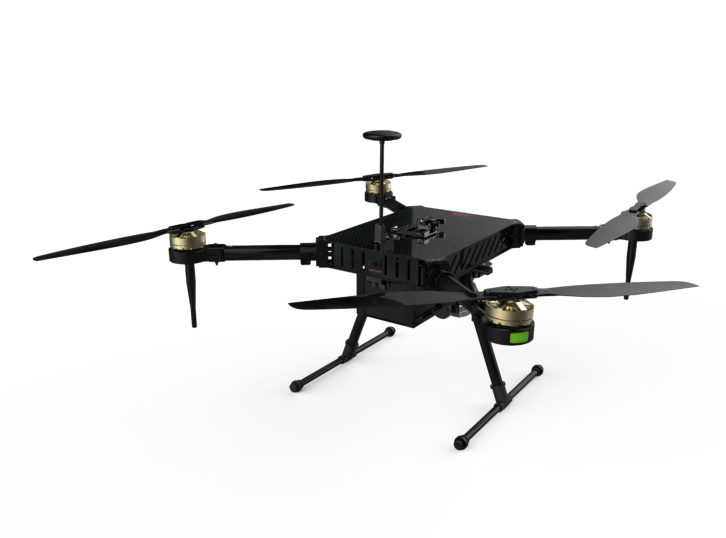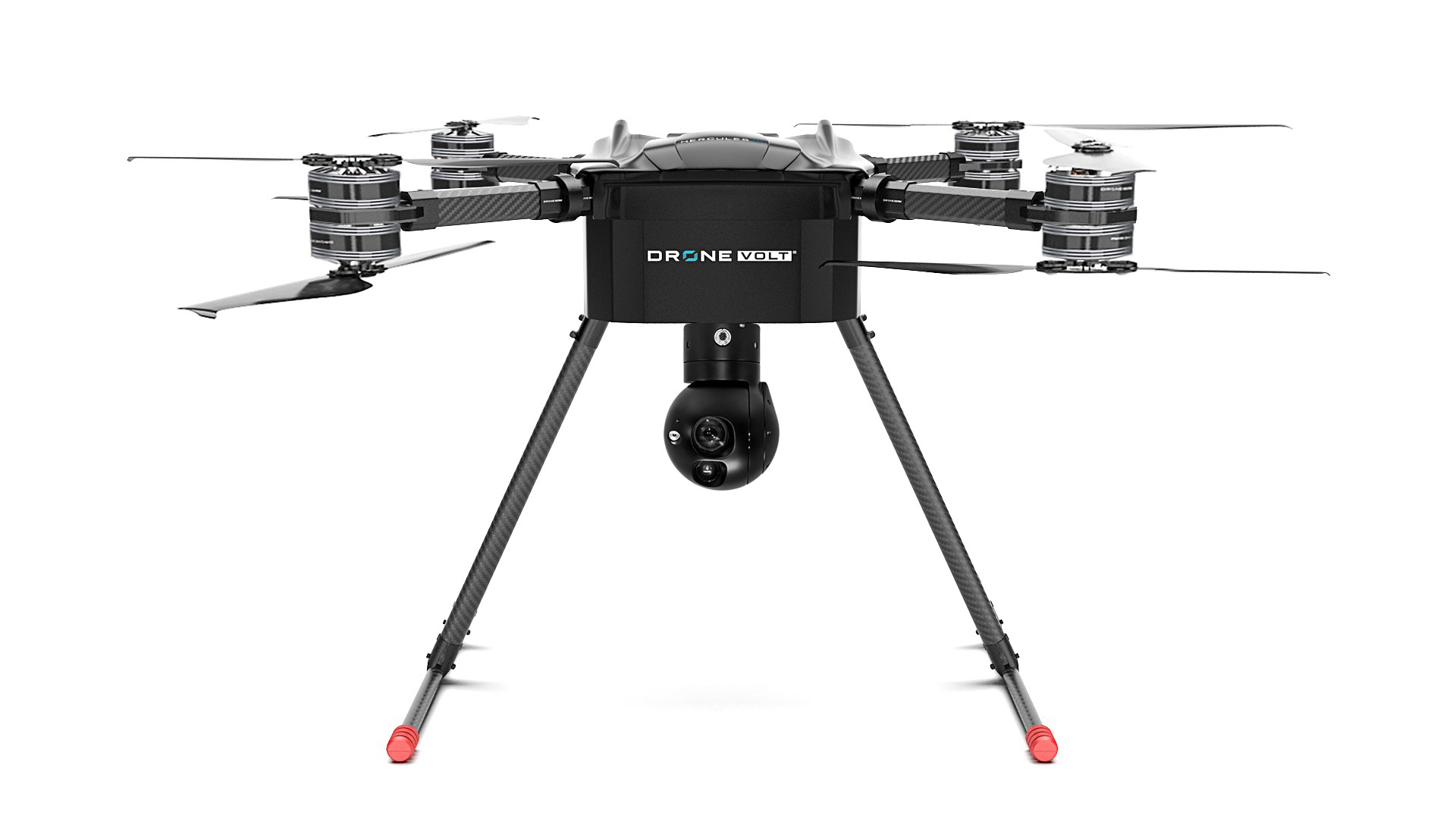
Few AV tools or systems have made the sudden and profound impact that drones have had on the industry. The implications of these new machines extend far beyond their immediate and specific AV applications and open rapidly evolving legal, safety and ethical issues which will affect their use and availability in the AV realm. The models shown here include the latest vehicles and camera systems being employed for aerial video and they demonstrate the rapid pace of sophistication in this fascinating technology.

At just over two feet long and capable of flying at a cruising speed of 30 miles per hour and a top speed of 40, the new Mach 4 from AEE Technology is operated with its Y-12 ground station (hand controller) in the 1.4Ghz frequency band. The system has three antennas attached to the ground station controller which provides 5.8GHz video transmission. The camera it normally carries is the YT35 standard 4K camera with a 1/2.3-megapixel sensor but an optional payload can include a 10:1 Zoom camera system and an advanced optical thermal camera. The Mach 4 drone can fly for up to 40 minutes per battery charge, extend control range to nearly two miles and the package comes with an aluminum-siding carrying case that includes a charger and battery pack.

The Altura Zenith from Aerialtronics is operable from a tablet control interface for beginners and an RF joystick for more precision flights. Combining an asymmetric monocoque carbon airframe with a configurable four or eight propeller design, the drone can be fitted with a wide choice of cinema cameras on a three-axis stabilized gimbal mount. Jitter-free video is assured by its special vibration dampeners. The fourpropeller ATX4 version can carry up to three pounds, fly for up to 45 minutes and it is light rain proof while the eight-prop ATX8 will lift over six pounds and cruise for up to 35 minutes on its 20.000 mAh battery hidden inside the airframe. The system can provide a full HD 1080i H.264 encrypted video link with a 2000 meter range. The 400-watt brushless motors and 16in. propellers can develop more than 35 pounds of vertical thrust. The Altura GCS app facilitates autonomous navigation and fully manual flights. The user can navigate via waypoint or use repetitive flight patterns.

The Autel Robotics EVO was unveiled at CES 2018 with its 4K UHD 60fps camera, obstacle avoidance systems and 30-minute flight time. The vehicle also features autonomous flight modes using waypoints, GPS/ GLONASS satellite positioning and a transmission range of nearly 5 miles. The Evo can draw a box around an object and autonomously follow it and once a point of interest is selected the drone can fly circles around it. Ultrasonic sensors and computer vision cameras on the bottom protect it from landing on sloped surfaces. The controller is built around a 3.3in. OLED screen that shows the camera view and all critical flight parameters.

Available in two variants depending on the camera used, the Mavic 2 Pro/Zoom from DJI is equipped with omnidirectional vision systems, obstacle sensing on all sides and infrared sensing. Its intelligent flight modes include Hyperlapse, Point of Interest, ActiveTrack 2.0, TapFly, QuickShots, and Advanced Pilot Assistance Systems (APAS). The Mavic 2 Pro is fitted with a Hasselblad L1D-20c camera using Natural Color Solution (HNCS) technology in shooting its 20 megapixel images while the Mavic 2 Zoom model has a 24-48mm optical zoom camera with a 1/2.3- inch 12-megapixel sensor. Both models use the latest 3-axis camera gimbal technology, up to 31 minutes of flight time and they support dynamic HDR photo, a technique that blends a sequence of photos for greater dynamic range and image clarity. 2.4Ghz to 5.8Ghz auto switching allows operation in busy RF areas.

Equipped with its 2-axis stabilized Sony QX100 camera payload and digital video downlink system, the Draganflyer Commander allows the user to monitor battery usage in real time on the handheld controller. The drone’s range sensor is fully integrated into the autopilot system and it works in conjunction with a precision barometric sensor to provide automatic takeoff and landing. The Draganflyer quick release (QR) system uses payload modules that snap into place without exterior cable connections. The craft has a dual battery system for safe power backup and once the flying is done, it folds into a very small 6.25in. package. The dual payload system includes a brushless 2-axis stabilized mount that houses two camera systems functioning as one. The patented quarter-turn mounting carbon fiber propellers are keyed to ensure proper placement on the appropriate motor and they include a centrifugal cooling system. The intelligent battery system has wireless link to Android devices and the app quickly displays battery status, history, temperature, and other parameters.

The Hercules 20 from Drone Volt is a tough machine with a pure carbon shock resistant frame and anodized 7075 aluminum fasteners. Spinning 27in. propellers that can be installed and removed without tools, it can lift up to 55lbs. and carry it up to 33 miles per hour in horizontal flight. The eight motors incorporate openings that provide cooling and the maximum flight time without payload is 72 minutes. For easy storage, it has foldable arms and the carbon landing gear is completely removable. 2.4Ghz band control and video transmission range is up to about six miles and the signal is AES 256 encrypted. The MN705S-125kv motors are specially designed for industrial drone applications and they are IP55 rated for water resistance. The bell cap’s centrifugal fan design actively cools the motor while grid shaped inlet holes and fin design of the motor base enlarges the heat dissipation area.

Carrying up to a 20lb. payload, the Freefly Systems Alta 8 airframe itself weighs only 13lbs. and its folded diameter, excluding propellers, is just under 26 inches. The eight Freefly F45 direct drive 3-Phase PMAC Outrunner motors each provide continuous output power of 350W at 6300RPM. The Alta propellers are carbon fiber with a balsa core. The Synapse control system features dual receivers and allows the user to execute complex flight paths while the velocity clamps provide an adjustable real time speed limit making it easy to perfectly repeat precise platform movements and duplicate camera shots. Through the Alta app the pilot can monitor parameters such as flight pack voltage, satellite count, flight mode, attitude, vibration, altitude and temperature. Using the Toad in the Hole quick release system both on top and underneath, the airframe can accept a camera mounted either way allowing unobstructed views up or down for specific types of shooting angles. Flight data logging is done on a micro SD card. The flight control and power distribution board is weather shielded in a lightweight molded plastic enclosure.

For extended flight time up to 200ft. over a specific area, the Hoverfly LiveSky tethered drone is equipped with a camera featuring 10x optical zoom and the system can provide optional thermal imagery. The tether carries video and allows unlimited power and secure communication while its Kevlar-strength line enables it to operate in RF and GPS denied areas either from fixed locations or from a moving ground vehicle. The system has built-in lead, flank and follow technology and operation is easy through a simple five-button controller for vehicle orientation and payload management. The LiveSky drone weighs less than 9lbs. and it is 20in. across. Riding on the four brushless motors, it can produce HD 1080p 30fps video and hold its place in 25mph wind.

Intel designed the Falcon 8+ to provide reliable performance in challenging conditions such as weak GPS areas, EMF environments and high winds. Its V-shaped form assists in unobstructed data acquisition and it can be flown as a closed system with non-transmitted onboard data storage. Using three redundant IMUs, the AscTec Trinity Control Unit provides redundancy for communications, batteries, rotors, and motors while it controls position, orientation and altitude. Payloads include high resolution imaging with the 42 megapixel Sony RX1R II camera, the 20 megapixel Sony R10C camera along with obstacle avoidance capabilities, the Sony 7R photo camera and the dual camera inspection payload. Intel’s Mission Control Software allows the operator to create both 2D and 3D flight plans and the Intel Powerpack batteries are designed for portability on airline flights. The Intel Cockpit Controller features a joystick that enables single hand vehicle control.

PD6B-Type II from Prodrone uses six single-prop motors spinning 28in. propellers to lift payloads up to 66lbs. and it uses interchangeable battery packs that can be located anywhere around the body to accommodate the payload and mission. The PSU (Prodrone Safety Unit) features a geo fence function that will automatically activate the parachute to bring it down safely if it deviates from the pre-set operating area. Depending on the payload, the flight endurance can be from 10 to 30 minutes and the maximum speed is just over 37mph on its four 16000mA batteries. One variant, the PD6B-AW-ARM, can be fitted with two high-performance, completely original 5-axis robotic arms. These arms can carry a maximum payload of approximately 22lbs. with a flight time of up to 30 minutes.

Walkera’s idea for maximum payload flexibility, reliability and safety is implemented in the Voyager 5 drone with its Flightsafety feature which includes a dual IMU, dual compass, and dual GPS system. It also uses a front facing infrared obstacle avoidance module. The 1.4/2.4GHz band video transmission distance is nearly 3 miles and it comes with the DEVO F18G remote controller. The Walkera Drone App interface shows battery levels, flight time, flight mode, number of satellites received, horizontal/vertical speed, camera zoom status and clicking the thumbnail map icon switches to the map interface. A cellphone snaps into the controller’s attached bracket to provide the display. The vehicle can perform auto takeoff and auto landing, while the controller can be set to Hyper IOC (Intelligent Orientation Control) Mode in which the drone can fly past something and pan itself to frame a shot without altering its course. The Voyager 5 can be fitted with 30x optical zoom camera with remote zoom control, a 4K camera, a thermal infrared camera or a low-light night vision camera. The craft is IP43 dustproof/waterproof and its detachable propellers, folding arms and folding landing gear allow it to have a very compact carrying size.

The xFOLD Cinema X8 drone is capable of handling heavy payloads up to 22lbs. for professional cinematography and it can be configured as quad, Hexa, x8 or x12 (4, 6, 8 or 12 motors and propellers set) to perform a variety of missions. An American made FAA Certified aircraft, the vehicle can be controlled by separate pilot and camera operators and it is compatible with all commercial grade flight controllers. Equipped with the default battery, it can fly for up to 23.5 minutes using 280KV490KV motors and 20in. propellers. The Toray 3K-weave carbon fiber frame provides a rugged and sturdy platform. The vehicle’s empty weight is 16lbs and its maximum recommended payload for 10.1 minutes of flight is 18lbs. using the stock 20in. propellers. The whole unit can fold down into a 22in. x 15in. x 11in. package. Designed to keep central gravity balanced with its quick release sliding gimbal mounting system, the Cinema X8 can carry a variety of camera payloads including Red, Alexa mini, FIZ systems and large cinema lenses.

Promoted as a hexacopter built for industrial use and ambitious professionals, the Yuneec H520 can carry a wide range of hot swappable payload options including thermal imaging, long focal length, or wide focal-length cameras. The android-based SD16S all-in-one controller has a 7-inch integrated screen along with the capability to be used in mission planning. The flight can be set up using the touch screen and then a single button push executes the plan. The H520 and the ST16S remote control communicate directly, avoiding the transmission of flight data, images, videos or logfiles to any external servers. Flights and camera moves can be stored and recalled with the Yuneec DataPilot software system. For more complex camera missions, the vehicle and camera control can be split up between two separate controllers and more detailed customization is possible through the company’s software development kit. Among the camera payload options is the E90 with its 20 megapixel 1-inch sensor and H2 high speed image processing chip. Capable of 4K video at 60fps, the E90 has a 23mm low distortion lens with a lens adapter ring threaded to fit 40.5 mm standard ND filters. The 3-axis stabilized gimbal provides a precision of +/- 0.02 degrees. The drone has a flight time up to 25 minutes with CGOET/E90.










